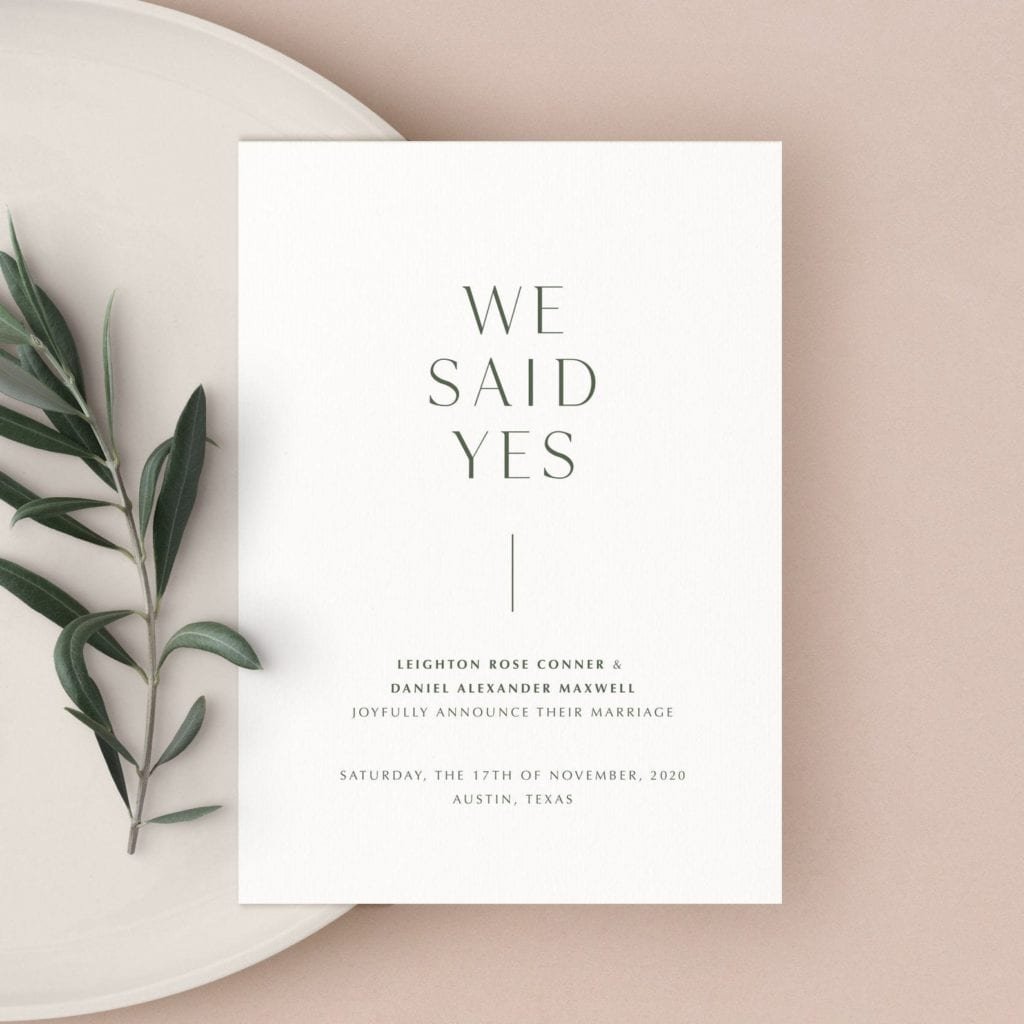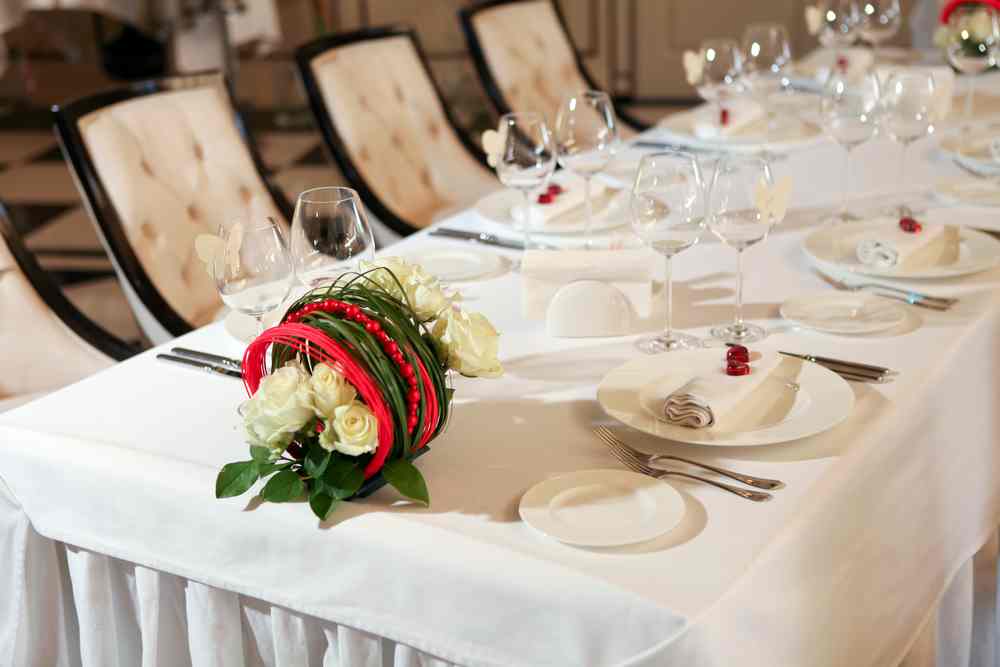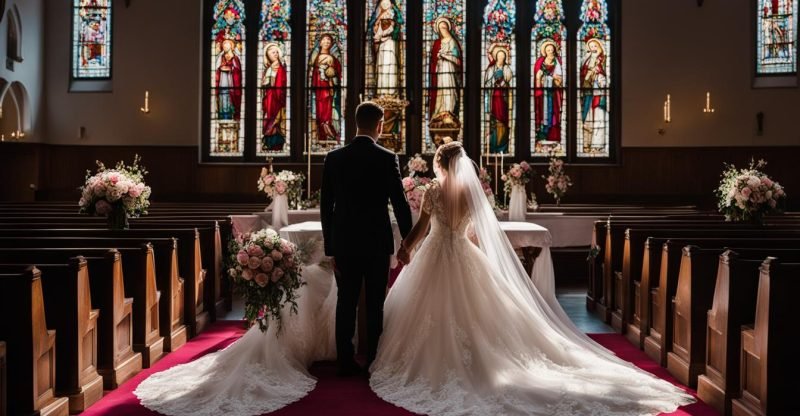Catholic Wedding Etiquette: A Comprehensive Guide
Catholic weddings are religious sacraments that involve specific rituals and traditions. Couples must go through a marriage preparation process with a priest, which includes discussing the teachings of the church and fulfilling certain requirements. Different dioceses may have different requirements, so it’s important to contact the parish where the wedding will take place.
Lead time for marriage prep is recommended to be nine months to a year. Certain documents, such as proof of baptism and participation in sacraments, may be required. Pre-Cana, a marriage-preparatory program provided by the church, is also mandatory. The wedding ceremony itself is held in a Catholic church and follows a structured format. Modesty in attire is generally expected, and certain customs, such as having a Best Woman or Man of Honor, can be personalized to some extent.
Key Takeaways:
- Catholic weddings involve specific rituals and traditions
- Couples must go through a marriage preparation process with a priest
- Lead time for marriage prep is recommended to be nine months to a year
- The wedding ceremony is held in a Catholic church and follows a structured format
- Modesty in attire is generally expected
Catholic Wedding Ceremony Protocol
A Catholic wedding ceremony is steeped in tradition and follows a structured format that emphasizes the sanctity of the event. Understanding the protocol can help ensure a smooth and meaningful ceremony for both the couple and their guests. Here are some key elements of Catholic wedding ceremony protocol:
H3: Processional and Recessional
One of the significant moments in a Catholic wedding is the processional, where the officiant, groom, best man, bridesmaids, and maid of honor enter the church. The bride is traditionally escorted by her father or godfather. It is a solemn and beautiful moment as the wedding party advances down the aisle. At the end of the ceremony, there is a recessional where the newlyweds, followed by their parents and guests, exit the church.
H3: Attire and Modesty
Modesty is highly valued in Catholic wedding ceremonies. It is customary for shoulders to be covered, and plunging necklines, sheer panels, and high slits are generally not allowed. It is recommended to consult with the priest or church for specific guidelines regarding attire. If a more revealing dress is desired, a shawl or wrap can be worn while inside the church.
H3: Full Mass or Shortened Ceremony
Catholic wedding ceremonies can either be a full Mass, which includes the Liturgy of the Eucharist, or a shortened ceremony without the Eucharistic celebration. The couple can discuss their preferences with the priest and decide which option aligns with their beliefs and desires. Personalized vows are not typically included in a Catholic wedding ceremony.
H3: Order of Events
A Catholic wedding ceremony follows a specific order of events. The couple exchanges marriage vows, rings, and receives a blessing from the priest. The ceremony may also include the Liturgy of the Word, where biblical readings and prayers are shared. Depending on the couple’s preferences and the church’s customs, the ceremony may incorporate other rituals such as the presentation of gifts or the lighting of unity candles.
Table: Key Elements of Catholic Wedding Ceremony Protocol
| Element | Description |
|---|---|
| Processional | The entrance of the wedding party into the church. |
| Recessional | The exit of the newlyweds and their guests from the church. |
| Attire and Modesty | Modest dress code with shoulders covered and no revealing attire. |
| Full Mass or Shortened Ceremony | The choice between a full Mass or a shortened ceremony without Communion. |
| Order of Events | The structured sequence of exchanging vows, rings, blessings, and other rituals. |
Understanding and respecting the Catholic wedding ceremony protocol can help couples create a memorable and sacred event that reflects their faith and values. By following these guidelines, couples can ensure a beautiful and meaningful ceremony that honors their Catholic traditions.
Catholic Wedding Traditions
Catholic wedding traditions are deeply rooted in the rich history and teachings of the Catholic Church. These traditions not only add a sense of sacredness to the ceremony but also symbolize the couple’s commitment to their faith and each other. Here are some of the key traditions you can expect to see in a Catholic wedding:
H3: Pre-Cana
Before getting married in the Catholic Church, couples are required to participate in a marriage preparation course called Pre-Cana. This program aims to provide guidance and support to couples as they embark on their journey of marriage. It covers various topics such as communication, conflict resolution, and the sacrament of matrimony. Pre-Cana helps couples deepen their understanding of their commitment and prepares them for a lifelong union.
H3: Nuptial Mass
The Nuptial Mass is a central part of any Catholic wedding ceremony. It is a solemn and sacred celebration of the couple’s love and commitment, witnessed by their family and friends. During the Nuptial Mass, the couple exchanges their marriage vows before God and their witnesses. The ceremony also includes the exchange of rings, the blessing of the couple, and the celebration of the Eucharist. It is a joyous occasion that signifies the couple’s union in the eyes of God and the Church.
H3: Decorum and Symbolism
Catholic weddings are known for their sense of decorum and symbolism. Modesty in attire is expected, with the bride typically wearing a white wedding gown symbolizing her purity and the groom wearing a suit or tuxedo. The use of symbols such as the crucifix, candles, and the marital unity candle adds to the sacredness of the ceremony. The presence of the wedding party, including the maid of honor, bridesmaids, best man, and groomsmen, also holds significant meaning, representing the couple’s closest friends and family.
| Symbol | Meaning |
|---|---|
| Crucifix | Symbolizes Christ’s sacrifice and the couple’s commitment to each other |
| Candles | Represent the light of Christ guiding the couple’s path |
| Marital Unity Candle | Symbolizes the merging of two lives into one |
As with any religious ceremony, it is important to respect and honor these traditions when attending a Catholic wedding. By doing so, you can fully appreciate the beauty and significance of the ceremony and join in celebrating the couple’s love and commitment.
Catholic Wedding Attire
When it comes to Catholic wedding attire, it is essential to dress modestly and respectfully. Catholic weddings are considered sacred ceremonies, and it’s important to adhere to the guidelines set by the church. Here are some key points to keep in mind:
- Covering of Shoulders: Some churches may require women to have their shoulders covered during the ceremony. It’s recommended to check with the church or priest to determine if this is a requirement.
- Avoid Revealing Outfits: Plunging necklines, sheer panels, deep-back gowns, and high slits are generally not allowed in Catholic weddings. It’s best to choose a dress that is modest and in line with the sanctity of the event.
- Consult with the Priest: If you have any doubts about what is appropriate to wear, it’s always a good idea to consult with the priest or the church. They can provide you with specific guidelines and ensure that your attire aligns with the customs of the Catholic wedding.
- Consider Wearing a Shawl or Wrap: If you have your heart set on a dress that may be more revealing, you can still wear it by pairing it with a shawl or wrap. This allows you to maintain the modesty required during the ceremony, while still wearing the dress of your choice.
Table: Catholic Wedding Attire Guidelines
| Do | Don’t |
|---|---|
| Dress modestly and respectfully | Wear revealing outfits |
| Consult with the priest or church | Assume what is appropriate |
| Consider wearing a shawl or wrap | Disregard the guidelines |
“When attending a Catholic wedding, it’s important to remember that the focus is on the sacred union of the couple. Dressing modestly and respectfully is a way to honor this special occasion and show respect for the religious traditions.”
By following the guidelines for Catholic wedding attire, you can ensure that your outfit is appropriate for the occasion and in line with the customs of the church. Dressing modestly and respecting the sacred nature of the ceremony will not only show your reverence but also contribute to the overall beauty and significance of the event.
Catholic Wedding Programs
When planning a Catholic wedding, creating a detailed program is essential to help your guests follow along with the ceremony. A well-designed program not only provides information about the order of events but also adds a personal touch to your special day. Here’s a guide to help you create a Catholic wedding program that is informative, meaningful, and visually engaging.
Order of Events
Start your program by outlining the order of events. Include key moments such as the processional, opening prayer, readings, exchange of vows and rings, the Nuptial Mass (if applicable), and the recessional. This will help guests anticipate what’s coming next and follow along with the flow of the ceremony.
Meaningful Readings and Hymns
Include the selected readings and hymns in your program, along with their titles and authors. You can also add a brief description of the readings, highlighting their significance and relevance to your relationship. This provides a deeper understanding and connection for your guests as they listen to the readings and participate in the hymns.
| Readings | Description |
|---|---|
| First Reading: Ephesians 5:21-33 | Highlights the importance of mutual love and respect in marriage. |
| Gospel Reading: John 2:1-11 | Tells the story of Jesus’ first miracle at the wedding in Cana, emphasizing his presence in marriage. |
Symbols and Traditions
Add a section in your program that explains the symbolism behind certain Catholic wedding rituals. For example, you can talk about the significance of the unity candle, the exchange of rings, and the unity cross. This will help guests understand the deeper meaning behind these traditions and appreciate their role in your union.
“The unity candle is a symbol of the couple’s individual lives coming together as one. As they light the candle together, it represents the merging of their families and the beginning of their new journey as a united couple.”
Thank You and Acknowledgments
End your program with a section to express your gratitude to your loved ones and those who have contributed to making your wedding day special. This can include your parents, bridal party, officiant, and any other individuals you wish to acknowledge. It’s a thoughtful gesture and allows you to show appreciation for their support and presence on this joyous occasion.
By designing a Catholic wedding program that incorporates the order of events, meaningful readings, symbolism, and acknowledgments, you can create a memorable keepsake for your guests while providing them with a deeper understanding of the significance of your Catholic wedding ceremony.
Catholic Wedding Processional Order
The processional order in a Catholic wedding is a carefully orchestrated sequence that sets the tone for the ceremony. It is important to follow the traditional processional order to ensure a smooth and meaningful entrance. Here is a breakdown of the typical processional order:
1. Officiant
The officiant, usually a priest or deacon, enters first and takes their place at the altar. They are responsible for leading the ceremony and guiding the couple through their vows.
2. Groom and Best Man
The groom, accompanied by his best man, walks down the aisle next. The best man stands by the groom’s side throughout the ceremony and may also hold the rings.
3. Bridesmaids and Groomsmen
The bridesmaids and groomsmen walk down the aisle in pairs, with the women on the left and the men on the right. They take their places at the front of the church, opposite the altar.
4. Maid of Honor
The maid of honor, the bride’s closest female attendant, follows the bridesmaids. She may carry the bride’s bouquet or hold on to it during the ceremony.
5. Bride
The bride makes her grand entrance, escorted by her father or godfather. This is a highly anticipated moment as the bride walks down the aisle towards her future spouse.
“The processional is a symbolic journey, representing the joining of two families and the start of a new chapter in the couple’s lives.” – Catholic Wedding Etiquette Expert
After the ceremony, there is a recessional, where the newlyweds walk back down the aisle followed by their parents and guests. The recessional order may vary depending on personal preferences and cultural traditions.
| Processional Order | Participants |
|---|---|
| 1 | Officiant |
| 2 | Groom and Best Man |
| 3 | Bridesmaids and Groomsmen |
| 4 | Maid of Honor |
| 5 | Bride |
By following the Catholic wedding processional order, couples can create a beautiful and meaningful entrance that honors tradition and sets the stage for a joyous celebration of love and commitment.
Catholic Wedding Dos and Don’ts
When attending a Catholic wedding, it’s important to respect the traditions and customs of the church. Here are some dos and don’ts to keep in mind:
Do:
- Attend the pre-wedding counseling sessions and follow the guidance of the priest. These sessions are designed to help the couple understand the significance of the sacrament of marriage and prepare them for their lifelong commitment.
- Dress modestly and respectfully for the ceremony. Avoid revealing or inappropriate attire that may detract from the sanctity of the event. It’s always a good idea to check with the church or the couple themselves if you’re unsure about the dress code.
- Participate in the rituals and prayers according to your comfort level and beliefs. Even if you’re not Catholic, you can still engage respectfully in the traditions of the church, such as standing, sitting, and kneeling when appropriate.
Don’t:
- Talk during the Mass or use phones or cameras. Maintaining a quiet and reverent atmosphere is important during the ceremony, as it is a time for prayer and reflection.
- Disrespect holy objects or symbols. Treat the church, the altar, and any religious artifacts with reverence and respect.
- Assume you can take Communion if you are not Catholic or don’t meet the requirements. In the Catholic faith, receiving the Eucharist is a sacred act reserved for those who are in a state of grace and have fulfilled the necessary requirements. If you’re not Catholic or haven’t received the sacraments, it’s best to remain in your seat during Communion.
- Attend the wedding without an invitation. Catholic weddings are often intimate affairs, and it’s important to respect the couple’s wishes and RSVP if you’ve been invited.
By following these dos and don’ts, you can ensure that you are respectful and supportive of the couple’s Catholic wedding ceremony. Remember, the focus of the day is on the couple and their commitment to each other, and your presence and respectful participation will contribute to the beauty and sanctity of the occasion.
Catholic Wedding Vows
Catholic wedding vows are an integral part of the sacrament of marriage. These vows are a solemn and sacred promise between the couple and God, affirming their commitment to love and honor each other for the rest of their lives. While Catholic wedding vows are generally not personalized, they hold deep meaning and significance. The language used in the vows reflects the traditional teachings of the church, emphasizing the lifelong nature of the commitment being made.
During the Catholic wedding ceremony, the couple stands before the altar and exchanges their vows. The wording of the vows may vary slightly between churches, but the essence remains the same. The vows typically include promises to love, honor, and cherish one another, to be faithful in good times and bad, and to accept children lovingly from God. These vows are a beautiful expression of the couple’s dedication to building a strong and loving marriage based on faith.
It is important to note that Catholic wedding vows are not just a declaration of love between the couple, but also a covenant made before God. The couple enters into this covenant with the understanding that their love and commitment are rooted in their faith and guided by the teachings of the Catholic Church. Through these vows, the couple invites God to be an active participant in their marriage, seeking His guidance and grace as they navigate the joys and challenges of life together.
Catholic wedding vows are a timeless tradition that symbolize the depth of love and commitment between a couple. They serve as a reminder of the sacred nature of marriage and the importance of faith in building a strong and lasting union. By exchanging these vows, couples embrace the beauty and responsibility of their shared journey, trusting in God’s presence and blessings throughout their married life.
Catholic Wedding Reception Customs
After the beautiful and sacred Catholic wedding ceremony, it’s time to celebrate with a reception that honors your faith and brings joy to your loved ones. Catholic wedding reception customs vary, but here are some common traditions you can consider.
Firstly, the reception usually begins with a grand entrance by the newlyweds. They are usually announced and make their way into the venue, marking the start of the celebratory festivities. This is a time for guests to offer their congratulations and well wishes to the happy couple.
During the reception, it is customary to have a formal meal where guests can enjoy delicious food and engage in conversation. The couple may choose to have a seated dinner or a buffet-style meal, depending on their preferences and the size of their guest list.
Another important tradition is the cutting of the wedding cake. This symbolic act represents the couple’s first task together as a married couple. The cake cutting ceremony is often accompanied by cheers and applause from guests, followed by the serving of the cake to the attendees.
FAQ
What is the process for Catholic marriage preparation?
Couples must go through a marriage preparation process with a priest, which includes discussing the teachings of the church and fulfilling certain requirements. Different dioceses may have different requirements, so it’s important to contact the parish where the wedding will take place. Lead time for marriage prep is recommended to be nine months to a year. Certain documents, such as proof of baptism and participation in sacraments, may be required. Pre-Cana, a marriage-preparatory program provided by the church, is also mandatory.
Where are Catholic weddings held?
Catholic weddings are held inside a church, emphasizing the sanctity of the event. Outdoor ceremonies are not allowed.
What is the attire expectation for a Catholic wedding?
Modesty is expected in attire, and some churches may require shoulders to be covered. It is recommended to consult with the priest or church for specific guidelines regarding attire. If a more revealing dress is desired, a shawl or wrap can be worn while inside the church.
What does a Catholic wedding program include?
Catholic wedding programs typically follow a structured format, including the order of events and readings. The program may include information about the couple, the wedding party, and the symbolism behind certain rituals. It can also include hymns and prayers that the congregation can participate in. The program serves as a guide for guests to follow along during the ceremony.
What is the order of the processional in a Catholic wedding?
The processional order in a Catholic wedding typically starts with the officiant, followed by the groom and best man. The bridesmaids and groomsmen walk down the aisle in pairs, with women on the left and men on the right. The maid of honor may follow, and the bride is escorted by her father or godfather. After the ceremony, there is a recessional, where the newlyweds walk back down the aisle followed by their parents and guests.
What are some dos and don’ts for attending a Catholic wedding?
Dos: Attend the pre-wedding counseling sessions and follow the guidance of the priest. Dress modestly and respectfully for the ceremony. Participate in the rituals and prayers according to your comfort level and beliefs. Don’ts: Talk during the Mass or use phones or cameras. Disrespect holy objects or symbols. Assume you can take Communion if you are not Catholic or don’t meet the requirements. Attend the wedding without an invitation.
Can Catholic wedding vows be personalized?
Catholic wedding vows are typically predetermined and not personalized. The couple will exchange vows, promising to love and cherish each other for the rest of their lives. The vows may vary slightly between churches, but the essence remains the same.







